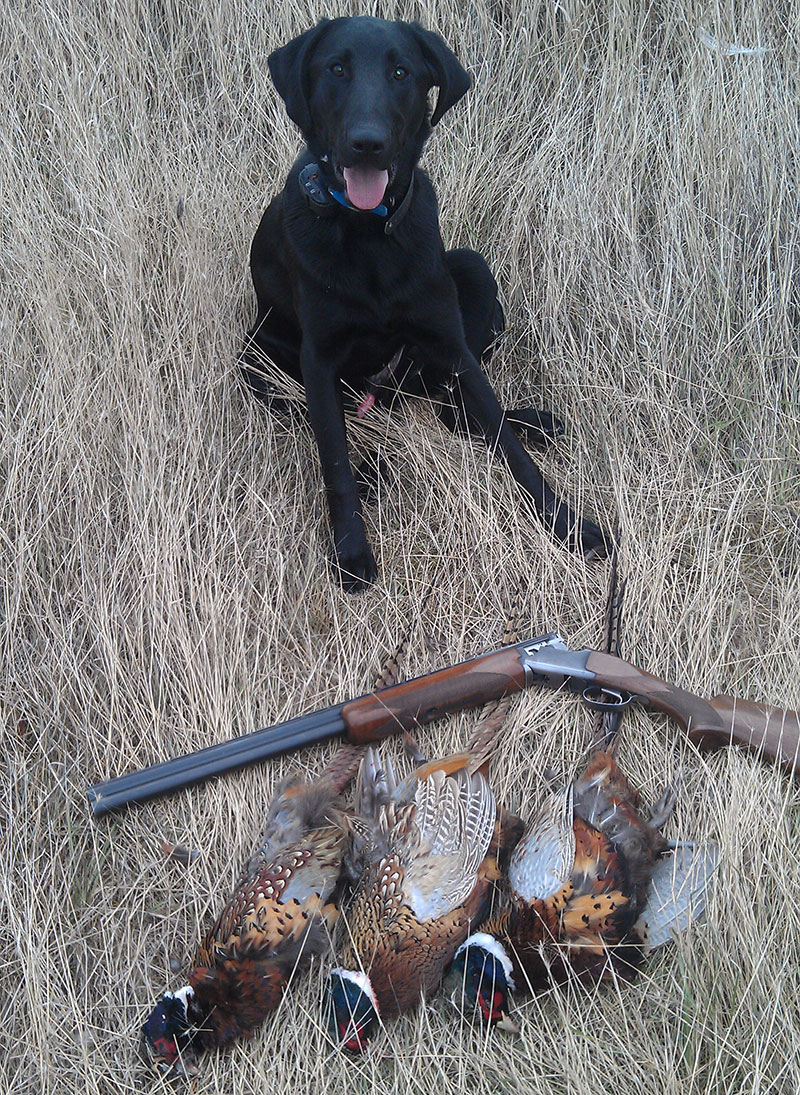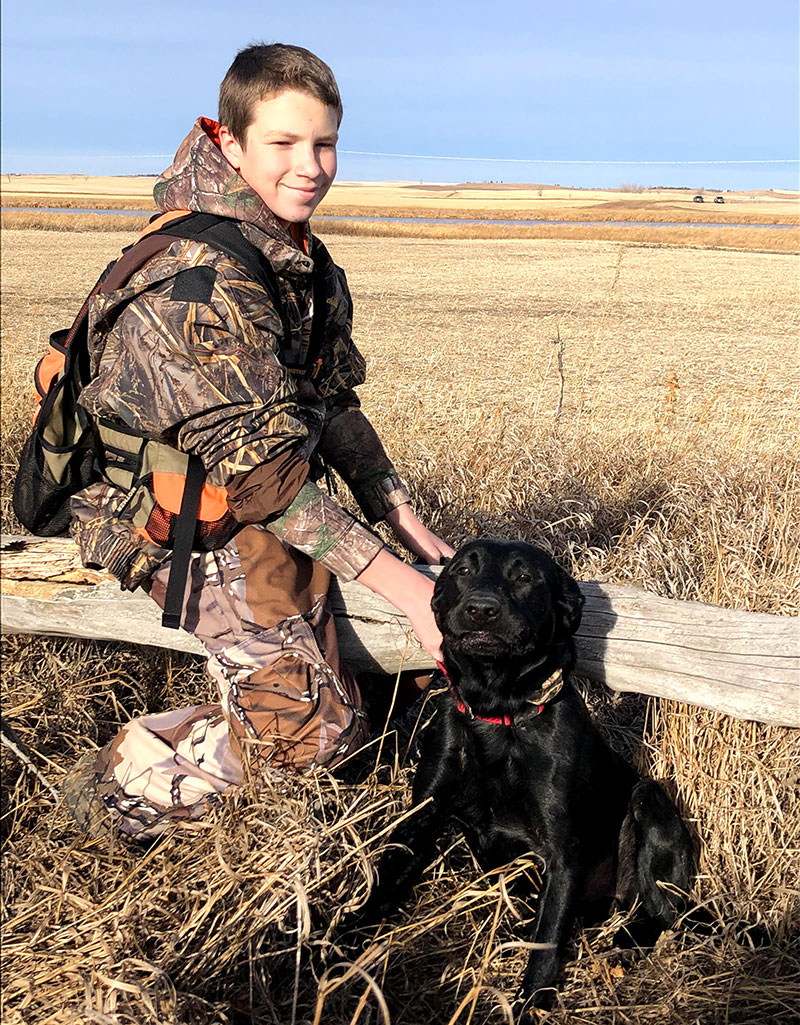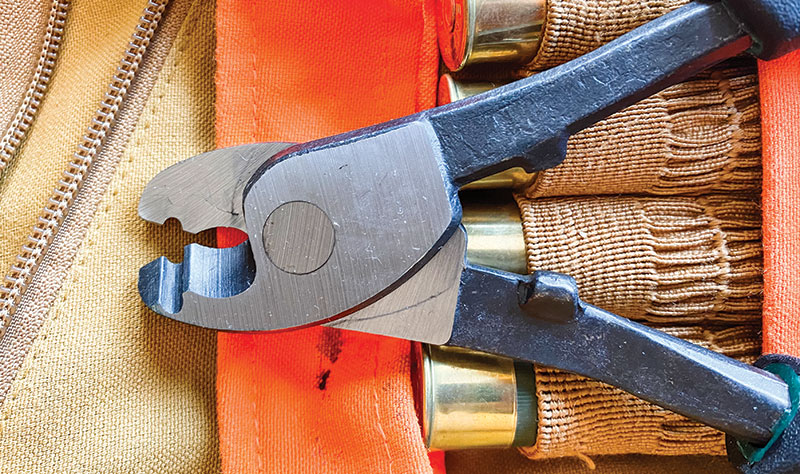Prep for the Unknown

Skeeter after a good day in the field.
Hunting late season pheasants has long been a favorite of mine, and since becoming a game warden, I’ve learned to enjoy it even more.
The end of North Dakota’s deer gun season in late November signals the crescendo for hunting seasons that started with the early Canada goose season in mid-August. After the close of the deer gun season the stresses of the fall hunting seasons fall off dramatically, but that doesn’t mean there aren’t great hunting opportunities to be had.
In December 2020, I and three other North Dakota wardens were able to find time off together for a late season pheasant hunt. Andrew Dahlgren, Jerad Bluem, Erik Schmidt and I found a day that we could all meet at a location determined by Erik. The day turned out to be the kind you hope for in December, cool with light wind.
The four of us executed our plan for the first couple of walks of the day and all was going well. We were finding some birds, each of us having a few chances at flushing roosters, and the dogs were all working well. After a short break, Erik assured us that the last walk of the day would be worth the effort.
I was looking forward to making one more push and even more excited for the end of the day to sit on the tailgate with friends and trade “warden stories” of the events that had taken place over the busy past few months.
We arrived at our final spot, unloaded the dogs and set out for the final walk. We walked some distance into the field and needed to cross a fence before getting into heavy cover that promised to hold birds.
Once on the other side of the fence someone commented on the blood in the snow. As we looked around, there was a lot of blood. During a quick inventory of the dogs, it was discovered that one of my black Labs, Skeeter, was bleeding from a cut on his right front leg. A small cut about a half-inch long on his lower leg. The amount of blood flowing from such a small cut was alarming. It was not spurting but was a steady hard flow and his paw was soaked.
Andrew and I took the big Lab to the ground so we could get a better look. I started applying pressure with my mitten as Andrew helped keep him calm and on his side. It was not long, and it was clear that the bleeding was not to be stopped that easily. Thankfully, Jerad is an emergency medical technician and had a first aid kit in his vehicle.
It was decided that Andrew and I would keep Skeeter down and continue to apply pressure on the cut while Erik and Jerad fetched the first aid kit. I was relieved to see them finally return with the kit in hand.
It was troubling that, even after applying pressure to the wound for some time, the blood would still flow so freely from the wound once the pressure was removed. Jerad’s training kicked in and he went to work wrapping the wound and making a compression bandage.
Before loading Skeeter into his kennel, we taped my already blood-soaked mitten around the bandage to prevent him from chewing it off on the ride to the veterinarian. A few quick calls and we discovered that none of the rural vet clinics in the area had anyone available, so I headed back into Bismarck a little over an hour away.

Nick Erck with Axl, one of the family's two black labs
I arranged for Skeeter to be seen by a veterinarian in Bismarck and the drive seemed like it took an eternity. After pulling into the clinic, I walked around to the back of my pickup, unsure of what I would find once I peered into his kennel. To my surprise he was alert and as happy as a Lab who had spent the day doing what he loves. The only blood in the kennel appeared to be what had come off his blood-soaked paw.
Once in the exam room I was even more impressed with the job Jerad had done with his field bandaging job. The veterinarian worked to take the bandage off to get a look at the small cut. I was shocked, once it was removed the blood returned at the same pace as earlier.
The fallout was a cut vein. The cut was small but went perfectly across a vein in his lower leg. A few small stitches and we were on our way home.
I was thankful that after all the excitement of the day it finally came to an end in less than dramatic fashion. My biggest disappointment was missing the “warden stories” at the end of our hunt.
As usually happens in a crisis, it is not until it is over that you grasp the magnitude of what took place. As I look back on the situation it brings to mind the Boy Scout motto: “be prepared.”
I was not!
I was troubled by all the “what ifs.” What if Jerad didn’t have a first aid kit. What if none of us knew how to stop the bleeding. The scariest of all, what if I was hunting alone.
After this incident in the field with my dog I wanted to take the opportunity to pass along the story to other hunters and dog owners to hopefully help them be more prepared than I was.
Without question, I will not take my dogs into the field without having a first aid kit. There are many commercial first aid kits for canines to pick from. If you would rather put together your own kit, a short visit with your veterinarian, a trip to your local drug store and you should be set. If you don’t know basic first aid, take the time to learn by taking a course or finding reliable information online.
Take it from the Boy Scouts and “be prepared” should such a situation occur to you in the field an hour from home.
COREY ERCK, Bismarck, is a Game and Fish Department district game warden.
Further Considerations

I strongly recommend that bird dog owners carry a bypass cable cutter while in the field to cut cable devices should their dog get caught in one.
Cable devices are used mainly to take coyotes. It is often difficult to know where cable devices may be set on private or public land. Do not rely on a regular side-cutter or your trusty multi-tool to get the job done, as cable devices are generally made of aircraft grade steel cable. A bypass cable cutter is a little extra money, but it will be money well spent if you ever find yourself in a situation where you need one.
One of the most common emergency situations is dogs overheating in the field on warm days. It can come on fast in either the hard-charging young dog or the experienced older dog. Most bird dog owners know the importance of carrying water and keeping their dogs hydrated, but as part of the first aid kit I recommend including at least one instant ice pack. If you are out in the field and your dog is in distress from the heat, you can activate the ice pack and hold it in their arm pit to help cool them down.
